What do people think about forest restoration in Europe? Insights from 12 countries
Authors: Moses Kazungu and Marcel Hunziker
(Swiss Federal Institute for Forest, Snow and Landscape Research WSL)
Forests shape people’s lives not only through their ecological functions but also through the ways they are perceived, valued, and managed. By first exploring what comes to mind when people think of forests, we can better understand their views on forest management and, more specifically, on forest restoration.
We asked four questions:
1. What do people think are the benefits of forests?
2. How familiar are people with forest restoration practices in Europe?
3. How do people perceive forest restoration to impact forest benefits?
4. To what extent are people willing to support restoration, and in what ways?
To answer these questions, we explored public perspectives across 12 SUPERB project countries: Sweden, Denmark, the Netherlands, Scotland, Germany, France, Italy, Spain, Serbia, Croatia, Czechia. We conducted qualitative interviews with key informants in 5 selected regions to gain initial insights into people’s relationships with forests and forest restoration (Kazungu & Hunziker, 2025). Based on this knowledge, we then conducted representative surveys of the public in these regions (Kazungu et al. 2025) and across all 12 SUPERB countries (online panel survey, n > 12,000).
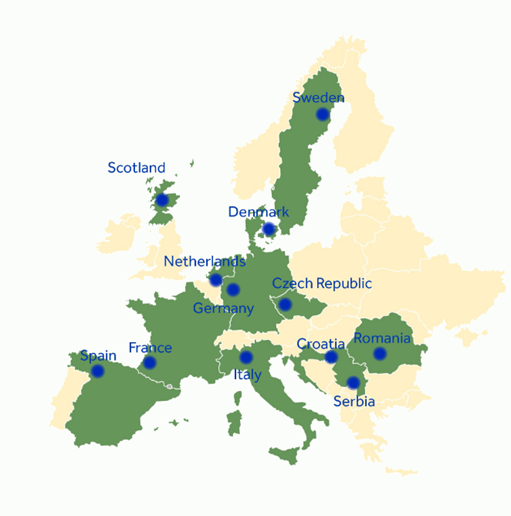
The SUPERB project extended over 12 countries with large-scale demo areas representing diverse stressors on European forests and a wide range of necessary restoration actions.
1. Perceived personal benefits from forests
Across all the 12 countries surveyed, respondents expressed consistently high appreciation for the personal and societal benefits provided by forests (Figure 1). Improvements in quality of life, the provision of wildlife habitat, and protection against natural hazards were among the most strongly endorsed benefits.
By contrast, more utilitarian or material aspects of forests—such as obtaining edible or non-edible materials (for example, mushrooms, berries, or timber products)—were rated lower in perceived importance.
These patterns indicate a broad, shared recognition of the positive contributions forests make to individual wellbeing and community life. The relatively uniform pattern across countries also highlights the pan-European nature of forest appreciation.
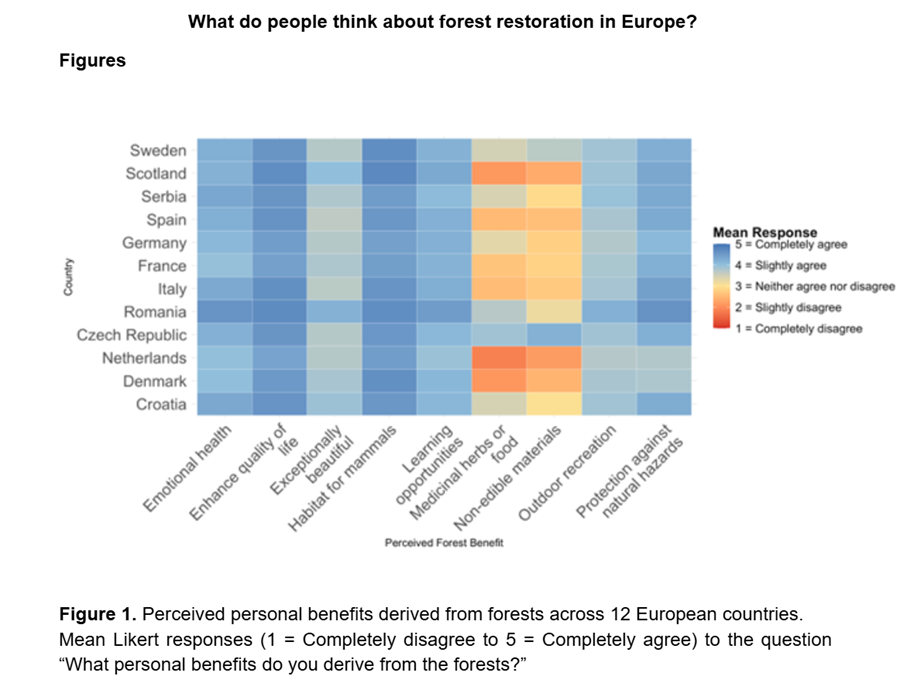
2. Awareness of forest restoration practices
Across the 12 study countries, public awareness of forest restoration varies widely (Figure 2). In many northern and central nations, up to half of the respondents reported not knowing about restoration activities in their local landscapes (Figure 2). Awareness was generally higher in southern and south-eastern Europe. The results indicate that familiarity increases with the visibility and social relevance of restoration efforts, revealing clear regional differences in how the public perceives and recognises forest restoration across Europe.
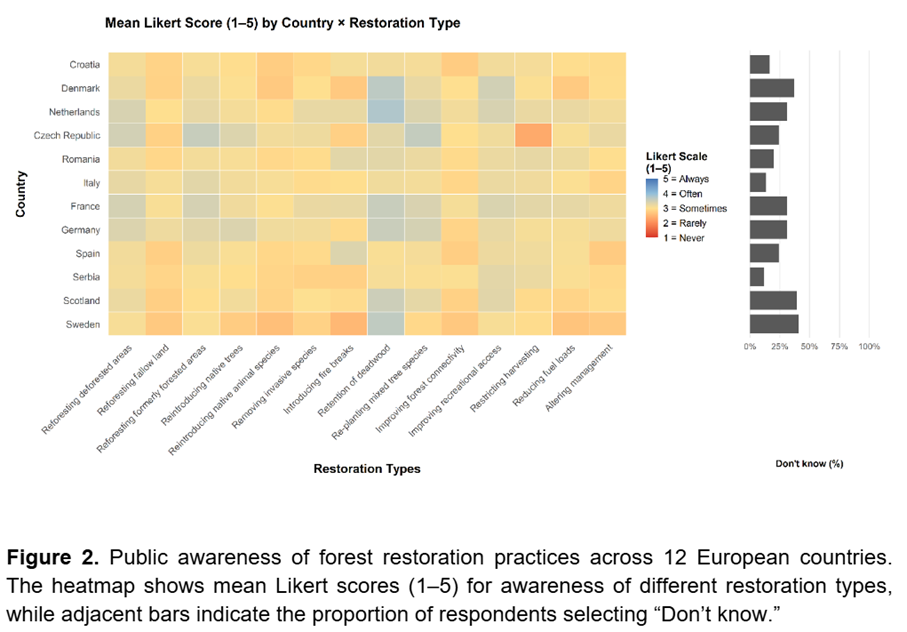
3. Perceived impacts of restoration on forest benefits
Perceptions of restoration impacts varied across the 12 countries and benefit types (Figure 3). While some respondents viewed restoration as having negative effects, especially on resource-use benefits such as firewood, timber, and hunting space, this pattern was not consistent across all regions. Habitat quality, species diversity, and recreational opportunities were more often perceived as positively affected. Overall, restoration was broadly seen as beneficial, though not uniformly so, highlighting how local experiences and livelihood connections shape public understanding of restoration outcomes across Europe (see also Kazungu et al. 2025).
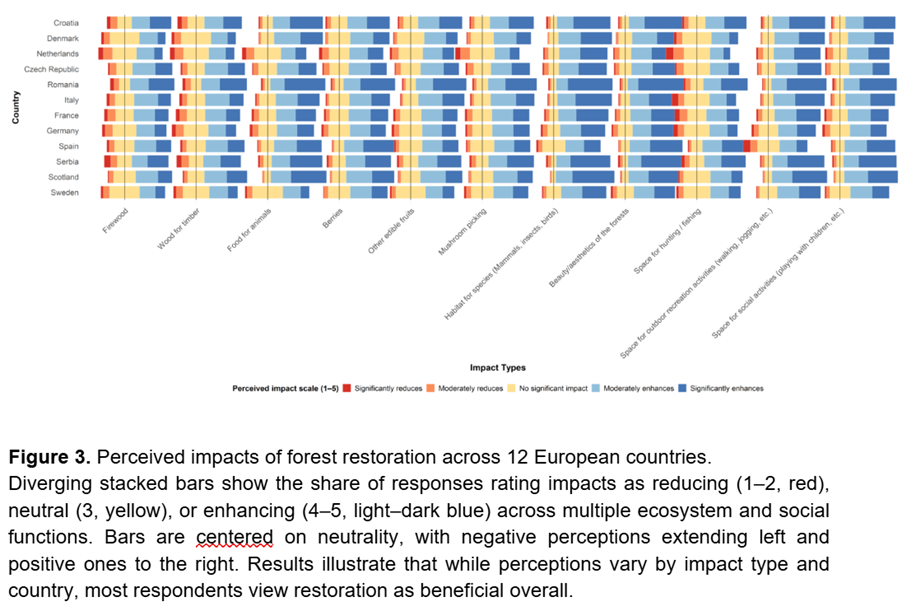
4. Willingness to support forest restoration
Overall, respondents across all 12 countries expressed a clear willingness to support forest restoration. However, levels of support varied considerably between regions with Eastern Europe showing strongest, Western and Southern Europe intermediate, and Northern and Central Europe lowest support for forest restoration (Figure 4). This suggests the need for more targeted engagement and communication strategies in Central and Northern areas to strengthen public understanding and commitment to restoration initiatives.
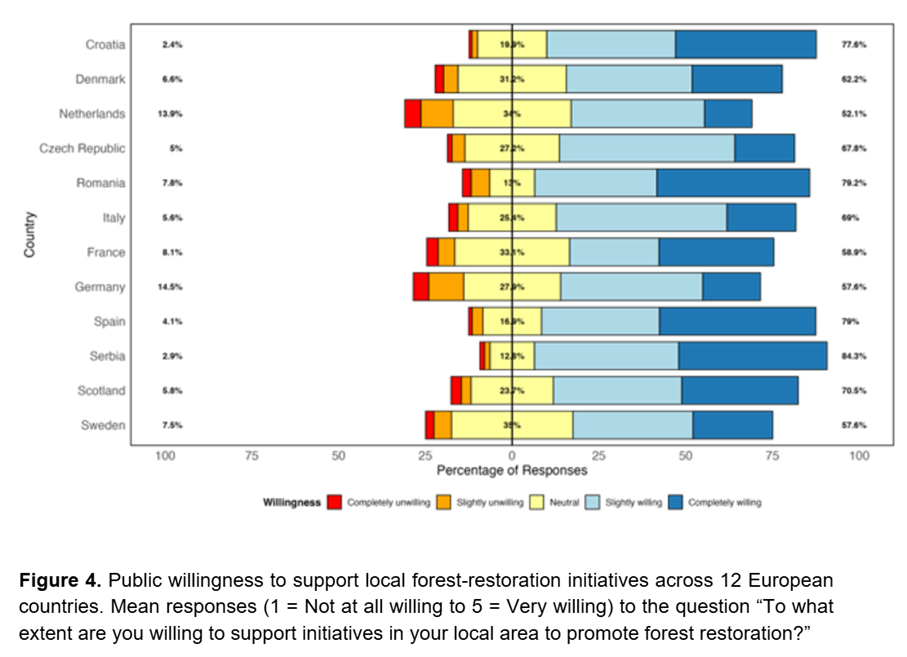
When asked about specific ways to support forest restoration, public preferences indicate strong support for policy advocacy and taxpayer-funded restoration measures. This preference suggests that people view restoration as a collective responsibility that should be financed publicly rather than relying on private contributions.
Conclusion
Our findings reveal that the European public are generally willing to support restoration despite diverse perceived impacts on forest benefits. The latter, however, might become a risk for public restoration support if not taken seriously and carefully addressed. Recognising both positive and negative perceptions, applying inclusive decision-making, where citizens are actively involved in shaping restoration strategies (O’Brien et al. 2025 and Horstmann et al. 2025), and tailoring approaches to regional contexts, will be essential for building trust and ensuring effective forest restoration across Europe.
References
Kazungu, M., & Hunziker, M. (2025). Exploring societal perceptions of forests, ecosystem benefits, and restoration. A case study in Sweden, Scotland, Germany, Serbia, Croatia, and Spain. Journal of Environmental Planning and Management, 1–23. https://doi.org/10.1080/09640568.2025.2490716
Kazungu, M., Svensson, J., Erdozain, M., de-Dios-García, J., Granberg, Å., & Hunziker, M. (2025). Factors influencing public support for forest restoration in Europe: evidence from Sweden and Spain. Ecosystems and People, 21(1), 2554695. https://doi.org/10.1080/26395916.2025.2554695
Nina Horstmann, Marcel Hunziker, Yulia Poskakukhina, Elisabeth Schatzdorfer, Kirsty Blackstock,Alhassan Ibrahim, Pilar Marín, Laura Puértolas, Agustín Sánchez-Arcilla, Iván Cáceres Rabionet, Craig Bullock, Emma E. Hart (2025). Stakeholder engagement for the development and implementation of National Restoration Plans – Key recommendations across ecosystem types. Policy and Practice Brief by the Restoration Cluster within H2020
O’Brien, L., A. Konczal, A. Begemann, M. Lovric, N. Lovric, S. Fleckenstein, G. Winkel (2025). Forest restoration paradigms and conflicts in Europe. International Forestry Review.
